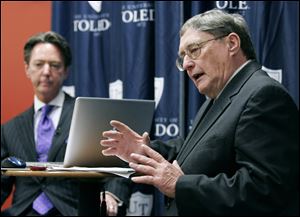
University of Toledo will lay off 87 to help eliminate a $16M shortfall
4/29/2009
Dr. Lloyd Jacobs, University of Toledo president, answered 20-plus questions during the town-hall meeting at which he announced the layoffs. In response to one, he said he did not relinquish a $150,000 bonus to help retain employees.
Nearly 100 employees at the University of Toledo will be laid off to help close a $16 million budget gap, UT President Dr. Lloyd Jacobs said Tuesday.
Those given pink slips are employees from all campuses. In addition, 200 positions left vacant because of a strict hiring process are being eliminated.
The affected employees include hourly workers, clerical and maintenance staff, and some management personnel. No faculty members were laid off.
"We can say today that [yesterday's action] has relieved and ameliorated the number of actual layoffs from perhaps as many as 300 down to approximately 100, and I am very proud of that result, actually. Thank goodness," Dr. Jacobs said.
He announced the layoffs during a regularly scheduled town-hall meeting in the recently renovated Memorial Field House. It was broadcast live on video.utoledo.edu, where it was archived and can be watched again.
The specific number of layoffs released to The Blade yesterday is 87 occupied positions - 46 on the main campus and 41 on the health science campus.
A total of 36 professional staff association employees (24 on the main campus, 12 on the health science campus) are included. Those are salaried management positions.
The layoffs will affect 22 Communications Workers of America workers on main campus, which include skilled trades, custodial, and maintenance staff.
And 24 members of the American Federation of State, County, and Municipal Employees on the health science campus will be laid off. Those include hourly workers in jobs from custodial to pharmacist.
Five other unspecified employees are also to be laid off.
The total number could change from 87 because some union employees have the option to "bump" into other positions.
Robert Hull, president of CWA Local 4319, which represents about 600 employees, said the union has been working with the university in imaginative and creative ways to save money without layoffs. "The university took the easy way out with the layoffs," he said.
Tom Kosek, president of AFSCME Local 2415, said a number of his union's 2,000 members are worried about where the cutting will end. "At what point does the institution fail in their mission while trying to maintain the budget parameters they've set?" he asked.
Dr. Jacobs spoke for about 12 minutes about the layoffs and then took more than 20 questions, including several about what alternatives to layoffs were considered.
The president said the university already has early retirement programs and that it looked into furloughs and other approaches, but those were not considered to be the first steps. Those could be options if more cuts are needed, which he said he didn't think would happen.
Dr. Jacobs was asked if he returned his bonus to allow lower-paid workers to stay. He said he did not.
Dr. Jacobs' contract from when he became president in July, 2006, included longevity bonuses of $150,000 if he stayed through June 30, which he did, and another $150,000 bonus if he stays through June 30, 2011.
A two-year contract extension approved by the UT board of trustees in October offered him another $150,000 longevity bonus if he stays through 2013.
Dr. Jacobs said that because his next bonus is not scheduled for a few years, he would consider where UT is at that time. "The people that are staying behind and continuing to commit and work hard, I believe need to be paid at market value," he said. "And I am below the market value."
Terry Cluse-Tolar, an associate professor of social work and chairman of the department who asked the question, said she was not pleased with his answer.
"I think in this economic climate, it's in really poor taste to accept that [bonus]," she said.
She and others were concerned that no concessions are made by the highest-paid members of UT's staff at the same time some of the lowest-paid employees are being laid off.
Elimination of the almost 300 jobs, between the layoffs and the vacant positions, as well as previous cost-cutting measures should help the university alleviate a projected $16 million shortfall for fiscal year 2010, the president said. When asked, he could not say exactly how much UT would save by the layoffs and the elimination of vacant jobs.
UT still will have about 6,900 UT employees serving university students and patients at the UT Medical Center, formerly the Medical College of Ohio Hospital, he said.
"We will continue to work hard, commit ourselves, do our mission, not be embittered by the difficult forces that impinge on us," Dr. Jacobs said. "If we do that, we can be a strong institution and continue to serve. If we don't, then we have run the risk of drying up, blowing away, and becoming irrelevant."
Contact Meghan Gilbert at:
mgilbert@theblade.com
or 419-724-6134.